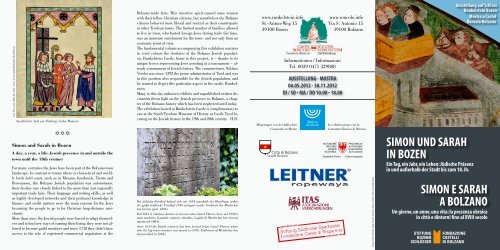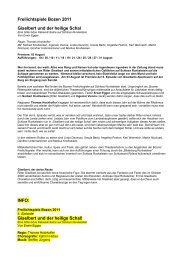Folder zur Ausstellung - Schloss Runkelstein
Folder zur Ausstellung - Schloss Runkelstein
Folder zur Ausstellung - Schloss Runkelstein
You also want an ePaper? Increase the reach of your titles
YUMPU automatically turns print PDFs into web optimized ePapers that Google loves.
Cod. Pal. germ. 848, fol. 355r - Foto: Universitätsbibliothek Heidelberg<br />
Sueskind der Jvde von Trimberg. Codex Manesse.<br />
A A A<br />
Simon and Sarah in Bozen<br />
A day, a year, a life: Jewish presence in and outside the<br />
town until the 18th century<br />
For many centuries the Jews have been part of the Bolzano town<br />
landscape. In contrast to towns where ecclesiastical and worldly<br />
lords held court, such as in Merano, Innsbruck, Trento and<br />
Bressanone, the Bolzano Jewish population was autonomous:<br />
their destiny was closely linked to the more than just regionally<br />
important trade fairs. Their language and writing skills, as well<br />
as highly developed networks and their profound knowledge in<br />
finance and credit matters were the main reasons for the Jews<br />
becoming the people to go to for Christian long-distance merchants.<br />
More than once, the Jewish people were forced to adapt themselves<br />
and to find new ways of earning their living: they were not allowed<br />
to become guild members and since 1718 they didn’t have<br />
access to the role of registered commercial negotiators at the<br />
Bolzano trade fairs. This inventive spirit caused some tension<br />
with their fellow Christian citizens, but nonetheless the Bolzano<br />
citizens behaved more liberal and neutral as their counterparts<br />
in other Tyrolean towns. The limited number of families allowed<br />
to live in town, who hosted foreign Jews during trade fair time,<br />
was an immense enrichment for the town- and not only from an<br />
economic point of view.<br />
The fundamental volume accompanying this exhibition narrates<br />
in vivid colours the destinies of the Bolzano Jewish population.<br />
<strong>Runkelstein</strong> Castle, home to this project, is – thanks to its<br />
unique fresco representing Jews assisting at a tournament – already<br />
a monument of Jewish history. The commissioner, Niklaus<br />
Vintler was since 1392 the prime administrator of Tyrol and was<br />
in this position also responsible for the Jewish population, and<br />
he wanted to depict this particular aspect in his castle, <strong>Runkelstein</strong>.<br />
Many to this day unknown exhibits and unpublished written documents<br />
throw light on the Jewish presence in Bolzano, a chapter<br />
of the Bolzano history which has been neglected until today.<br />
The exhibition hosted at <strong>Runkelstein</strong> Castle is complementary to<br />
one at the South Tyrolean Museum of History at Castle Tyrol focusing<br />
on the Jewish history in the 19th and 20th century. H.R.<br />
Der jüdische Friedhof befand sich seit 1614 unterhalb der Haselburg, wohin<br />
der große städtische Friedhof 1930 verlagert wurde. Grabstein des Mordechai<br />
ben Gerson (gest. 1804).<br />
Dal 1614 il cimitero ebraico si trovava sotto Castel Flavon, dove nel 1930 è<br />
stato trasferito il grande cimitero cittadino. Lapide di Mordechai ben Gerson<br />
(morto nel 1804).<br />
Since 1614 the Jewish cemetery has been located below Castel Flavon, where<br />
also the big town cemetery was moved in 1930. Tombstone of Mordechai ben<br />
Gerson (died in 1804).<br />
Foto: 3D-Pixel<br />
www.runkelstein.info<br />
St.-Anton-Weg 15<br />
39100 Bozen<br />
Mitgetragen von der Jüdischen<br />
Gemeinde zu Meran<br />
Informationen / Informazioni<br />
Tel. 0039 0471 329808<br />
AUSSTELLUNG - MOSTRA<br />
04.05.2012 - 30.11.2012<br />
DI / SO • MA / DO 10.00 • 18.00<br />
www.roncolo.info<br />
Via S. Antonio 15<br />
39100 Bolzano<br />
In collaborazione con la<br />
Comunità Ebraica di Merano<br />
Design: Roland Prünster, Eppan • Druck: Tezzele by Esperia, Bozen • Foto Ochsenreiter Bozen<br />
SIMON UND SARAH<br />
IN BOZEN<br />
Ein Tag, ein Jahr, ein Leben: Jüdische Präsenz<br />
in und außerhalb der Stadt bis zum 18. Jh.<br />
<strong>Ausstellung</strong> auf <strong>Schloss</strong><br />
<strong>Runkelstein</strong> Bozen<br />
Mostra a Castel<br />
Roncolo Bolzano<br />
SIMON E SARAH<br />
A BOLZANO<br />
Un giorno, un anno, una vita: la presenza ebraica<br />
in città e dintorni fino al XVIII secolo<br />
STIFTUNG<br />
BOZNER<br />
SCHLÖSSER<br />
FONDAZIONE<br />
CASTELLI<br />
DI BOLZANO
Simon und Sarah in Bozen<br />
Ein Tag, ein Jahr, ein Leben: Jüdische Präsenz in und<br />
außerhalb der Stadt bis zum 18. Jh.<br />
An ihren Spitzhüten erkennbare<br />
Juden beobachten das <strong>Runkelstein</strong>er<br />
Lanzenturnier. Die<br />
Darstellung ist auf nach 1392<br />
datierbar.<br />
Degli ebrei riconoscibili dai<br />
loro cappelli a punta assistono<br />
al torneo di lance di Castel<br />
Roncolo. La rappresentazione è<br />
databile a dopo il 1392.<br />
Jewish, as we can deduct from<br />
their pointed hats, assist at the<br />
<strong>Runkelstein</strong> Castle jousting.<br />
The fresco can be dated back as<br />
to after 1392.<br />
Jahrhundertelang gehörten die Juden zum Bozner Alltagsbild.<br />
Im Unterschied zu den Residenzstädten wie Meran,<br />
Innsbruck, Trient und Brixen war das Schicksal der Bozner<br />
Juden nicht von weltlichen und geistlichen Herren abhängig,<br />
sondern mit den überregional bedeutenden Jahrmärkten verknüpft.<br />
Sprach- und Schriftkompetenz, weitreichende Verbindungen,<br />
Fachwissen im Kredit- und Geldwesen machten die Juden<br />
Im königlichen Mandat Ferdinands I. vom Jahr 1551 wird den Juden in Tirol<br />
das Tragen eines gelben Ringes vorgeschrieben.<br />
Il mandato reale di Ferdinando I del 1551 prescrive agli ebrei in Tirolo di<br />
portare un anello giallo.<br />
The royal writ issued by Ferdinand I in 1551 obligates all Jews in Tyrol to<br />
identify themselves by wearing a yellow ring.<br />
Foto: Tiroler Landesarchiv Innsbruck<br />
zu erwünschten Ansprechpartnern christlicher Fernhändler.<br />
Immer wieder waren die Juden gezwungen, neue Existenzgrundlagen<br />
zu finden, zumal sie keiner Zunft angehören und<br />
ab 1718 nicht mehr als zugelassene Geschäftsvermittler an<br />
den Bozner Messen tätig sein durften. Dies brachte auch so<br />
manche Spannung mit den Einheimischen mit sich. Trotzdem<br />
waren die Bürger der Messestadt um einiges liberaler und<br />
neutraler als die der anderen Tiroler Städte. Für Bozen bil-<br />
ןיצבמ ןושרג ןב יכדרמ ןוזי<br />
ןיצבמ ןשרג ןב יכדרמ ןוזי<br />
IZUN MORDECHAI BEN GERSON DI BOLZANO<br />
Unterschrift:<br />
Firma:<br />
Signature:<br />
Mordechai Ben Gerson<br />
Bozen - Bolzano<br />
deten die wenigen in der Stadt zugelassenen Familien, die zu<br />
Messezeiten ihre auswärtigen Glaubensbrüder beherbergten,<br />
eine Bereicherung und dies nicht nur in wirtschaftlicher Hinsicht.<br />
Der grundlegende Begleitband <strong>zur</strong> <strong>Ausstellung</strong> schildert in<br />
lebendiger Weise die Schicksale von Bozner Juden.<br />
<strong>Runkelstein</strong> als Ort der <strong>Ausstellung</strong> „Simon und Sarah“ ist<br />
über das einmalige Fresko, das Juden am Rande eines ritterlich-nostalgischen<br />
Turniers zeigt, ein Denkmal jüdischer Geschichte.<br />
Der Auftraggeber Niklaus Vintler hatte seit 1392 als<br />
oberster Amtmann die Aufsicht über die Juden von ganz Tirol<br />
erhalten und wollte in seiner Vorzeigeburg <strong>Runkelstein</strong> auch<br />
bildlich darauf hinweisen.<br />
Eine Menge von bisher unbekannten Exponaten und unpublizierten<br />
Schriftdokumenten beleuchtet in allgemein zugänglicher<br />
Weise die bisher vernachlässigte Erforschung des jüdischen<br />
Daseins in Bozen.<br />
Porträt des Lazarus Josef Levi<br />
(1743-1806) aus Hohenems,<br />
der an den Bozner Messen tätig<br />
war.<br />
Ritratto di Lazarus Josef Levi<br />
(1743-1806) di Hohenems,<br />
commerciante alle fiere<br />
mercantili di Bolzano.<br />
Portrait of Lazarus Josef Levi<br />
(1743-1806) from Hohenems,<br />
trader at the Bolzano trade<br />
fairs.<br />
Foto: Jüdisches Museum Hohenems<br />
Diese <strong>Ausstellung</strong> bildet eine Ergänzung zu einer gleichzeitig<br />
vom Landesmuseum für Kultur- und Landesgeschichte auf<br />
<strong>Schloss</strong> Tirol gezeigten <strong>Ausstellung</strong>, welche die Zeit vom 19.<br />
bis zum 20. Jahrhundert behandelt. H.R.<br />
A A A<br />
Simon e Sarah a Bolzano<br />
Un giorno, un anno, una vita: la presenza ebraica in<br />
città e dintorni fino al XVIII secolo<br />
Per secoli gli ebrei erano parte della vita quotidiana di Bolzano.<br />
A differenza delle città dove c’erano corti (Merano, Innsbruck)<br />
o sedi vescovili (Trento, Bressanone), il destino degli<br />
ebrei era strettamente legato alle fiere annuali che avevano<br />
un’importanza sovra-regionale.<br />
La loro capacità di parlare e scrivere in più lingue, le loro ampie<br />
connessioni e la conoscenza in materia di denaro e credito<br />
rendevano gli ebrei partner commerciali ideali per i commercianti<br />
cristiani ad ampio raggio.<br />
Gli ebrei erano costretti continuamente a “scoprire” nuovi<br />
mestieri, soprattutto perché non potevano appartenere a una<br />
Ansicht von Bozen mit farbig hervorgehobenen Häusern der Juden und den<br />
Judengassen. Kupferstich von Matthias Merian d. Ä. von 1648.<br />
Veduta di Bolzano con le case degli ebrei e i cosiddetti „Judengassen”, cioè i<br />
vicoli ebrei evidenziati. Incisione su rame di Matthias Merian del 1648.<br />
View on the town of Bolzano with the Jewish houses and alleys all pointed out.<br />
Engraving on copper by Matthias Merian Sr. from 1648.<br />
Foto: Südtiroler Landesarchiv - Archivio Provinciale di Bolzano<br />
Lageplan (1801) der Bozner Synagoge, des sog. Judenhauses, südlich der<br />
Dominikanerkirche.<br />
Mappa (1801) della sinagoga di Bolzano, la cosiddetta Casa Ebrea, a Sud<br />
della chiesa dei Domenicani.<br />
Map (1801) of the Bolzano synagogue, the so-called Jewish House, located at<br />
the South of the Dominican order’s church.<br />
corporazione, e, dal 1718 non potevano più fungere da sensali<br />
autorizzati alle fiere bolzanine. Questo comportò qualche frizione<br />
con i concittadini. Ciononostante i Bolzanini erano più<br />
liberali e tolleranti rispetto alle altre città tirolesi.<br />
Le poche famiglie ebree autorizzate a risiedere in città e che<br />
durante le fiere ospitavano gli ebrei in transito rappresentavano<br />
un arricchimento per Bolzano, non solo dal punto di vista<br />
economico.<br />
Il volume che accompagna la mostra “Simon e Sarah” a Bolzano<br />
dipinge un quadro vivido della sorte degli ebrei bolzanini<br />
fino ad ora non trattato in modo esauriente.<br />
Castel Roncolo, sede della mostra “Simon e Sarah” può essere<br />
considerato un monumento della storia ebraica grazie<br />
al suo affresco che mostra degli ebrei mentre assistono a un<br />
nostalgico torneo cavalleresco. Il committente degli affreschi,<br />
Niklaus Vintler, in qualità di più alto funzionario del Tirolo,<br />
aveva ricevuto la responsabilità per gli ebrei di tutta la regione<br />
e voleva renderlo noto anche visivamente nel suo maniero di<br />
prestigio.<br />
Una grande quantità di oggetti fino ad ora sconosciuti e di<br />
documenti non ancora pubblicati farà luce in un campo ancora<br />
poco esplorato. La presenza ebraica a Bolzano rappresenta<br />
una parte importante della storia cittadina.<br />
Inoltre, una mostra allestita a Castel Tirolo, sede del Museo<br />
storico-culturale della Provincia di Bolzano, tratterà il periodo<br />
storico successivo, ossia il XIX e il XX secolo. H.R.



